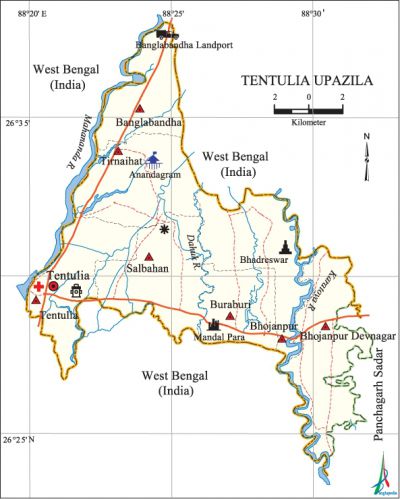Tentulia Upazila
Tentulia Upazila (panchagarh district) area 189.12 sq km, located in between 26°24' and 26°38' north latitudes and in between 88°21' and 88°33' east longitudes. Extreme northern upazila of Bangladesh is bounded by west bengal state of India on the north, south and west, panchagarh sadar upazila on the east.
Population Total 105368; male 54078, female 51290; Muslim 103277, Hindu 1963, Buddhist 119 and others 9. Indigenous communities such as santal and rajbangshi belong to this upazila.
Water bodies Main rivers: Dahuk, karatoya, mahananda.
Administration Tentulia Thana was formed on 26 June 1917 and it was turned into an upazila on 16 March 1993.
| Upazila | ||||||||
| Municipality | Union | Mouza | Village | Population | Density (per sq km) | Literacy rate (%) | ||
| Urban | Rural | Urban | Rural | |||||
|
- |
7 |
36 |
244 |
4732 |
100636 |
557 |
57.4 |
38.1 |
| Upazila Town | |||||
|
Area (sq km) |
Mouza |
Population |
Density (per sq km) |
Literacy rate (%) | |
|
4.23 |
1 |
4732 |
1119 |
57.4 | |
| Union | ||||
| Name of union and GO code | Area (acre) | Population | Literacy rate (%) | |
| Male | Female | |||
|
Tirnaihat 94 |
7493 |
7702 |
7222 |
40.37 |
|
Tentulia 81 |
6303 |
9091 |
8648 |
43.70 |
|
Banglabandha 13 |
5194 |
6357 |
5976 |
40.56 |
|
Buraburi 54 |
4530 |
4983 |
4945 |
39.62 |
|
Bhojanpur Debnagar 40 |
8233 |
9849 |
9391 |
35.37 |
|
Bhojanpur 27 |
7339 |
6914 |
6495 |
37.50 |
|
Salbahan 67 |
7632 |
9182 |
8613 |
36.32 |
Source Bangladesh Population Census 2001,Bangladesh Bureau of Statistics.

Archaeological heritage and relics Bhadreswar Temple, Shiva Temple, Mausoleum built as per design of the Greek architecture, Tentulia Dakbungalow.
Religious institutions Mosque 120, temple 2.
Literacy rate and educational institutions Average literacy 39%; male 44.1%, female 33.5%. Educational institutions: college 4, secondary school 27, primary school 67, kindergarten 3, madrasa 11. Noted educational institutions: Kazi Shahabuddin Girls' School and College (1965), Tentulia College (1986), Bhojanpur' Degree College (1987), Tentulia Technical College (2004), Boda Mainaguri Bilateral High School (1917), Bhojanpur Bilateral High School (1956), Salbahan Bilateral High School (1962), Tentulia Pilot High School (1959), Majhipara Bilateral High School (1973), Haradighi Bilateral High School (1969), Kalandiganj Senior Madrasa (1976), Begum Fakhrunnisa Fazil Madrasa (1978).
Cultural organisations Library 1, club 16, music school 1, cinema hall 1, theatre group 1.
Amusement centres Tentulia Picnic Corner, Dahuk Picnic Centre, Anandadhara and Tea Garden at Raushanpur,' Zero Point and Landport at Banglabandha.
Main sources of income Agriculture 61.72%, non-agricultural labourer 16.01%, commerce 8.84%, transport and communication 2.33%, service 4.38%, construction 0.46%, religious service 0.09%, rent and remittance 0.09% and others 6.08%.
Ownership of agricultural land Landowner 54.75%, landless 45.25%; agricultural landowner: urban 39.45% and rural 55.51%.'
Main crops Paddy, jute, wheat, sugarcane, potato, garlic, vegetables.
Extinct or nearly extinct crops Kaun, barley, mustard, sweet potato, arahar, linseed.
Main fruits Mango, blackberry, jackfruit, litchi, watermelon, papaya, pineapple, orange.
Communication facilities Pucca road 46 km, mud road 422 km.
Extinct or nearly extinct traditional transport Palanquin, horse carriage, bullock cart.
Cottage industries Potteries, weaving, jute work, bamboo work.
Hats, bazars and fairs Hats and bazars are 14, most noted of which are Tentulia Bazar, Salbahan Hat, Bhojanpur Hat, Sepaipara Hat, Tirnaihat, Buraburi Hat and Muhurir Hat.
Main exports Watermelon, pineapple, jackfruit, papaya, garlic, gravel.
Access to electricity All the unions of the upazila are under rural electrification net-work. However 4.36% of the dwelling households have access to electricity.
Natural resources' Glass Sand, Bolder Stone, stone chips.
Sources of drinking water Tube-well 81.24%, tap 0.49%, pond 0.81% and others 17.46%.
Sanitation 11.51% (rural 9.98%' and urban 42.21%) of dwelling households of the upazila use sanitary latrines and 44.71% (rural 44.46% and urban 49.81%) of dwelling households use non-sanitary latrines; 43.78% of households do not have latrine facilities.
Health centres Upazila health complex 1, family planning centre 6, satellite clinic 3.
Natural disasters The earthquake of 1942 and the flood of 1968 caused heavy damages to settlements and other properties of the upazila.
NGO activities Operationally important NGOs are brac, RDRS. [Shahidul Islam Shahid]
References Bangladesh Population Census 2001, Bangladesh Bureau of Statistics; Cultural survey report of Tentulia Upazila 2007.
